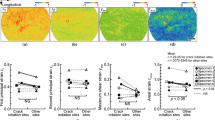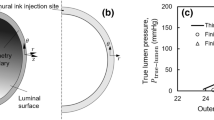Abstract
Aortic dissection occurs predominantly in the thoracic aorta and the mechanisms for the initiation and propagation of the tear in aortic dissection are not well understood. We study the tearing characteristics of the porcine thoracic aorta using a peeling test and we estimate the peeling energy per unit area in the ascending and the descending segments. The stretch and the peel force per unit width undergone by the peeled halves of a rectangular specimen are measured. We find that there can be significant variation in the stretch within the specimen and the stretch between the markers in the specimen varies with the dynamics of peeling. We found that in our experiment the stretch achieved in the peeled halves was such that it was in the range of the stretch at which the stress–stretch curve for the uniaxial experiment starts deviating from linearity. Higher peeling energy per unit area is required in the ascending aorta compared to the descending aorta. Longitudinal specimens required higher peeling energy per unit area when compared to the circumferential specimens.







Similar content being viewed by others
References
Alfson, D. B., and S. W. Ham. Type b aortic dissections: current guidelines for treatment. Cardiol. Clin. 35(3):387–410, 2017.
Angouras, D. C., E. P. Kritharis, and D. P. Sokolis. Regional distribution of delamination strength in ascending thoracic aortic aneurysms. J. Mech. Behav. Biomed. Mater. 98:58–70, 2019.
Atienza, J. M., G. V. Guinea, F. J. Rojo, R. J. Burgos, C. García-Montero, F. J. Goicolea, P. Aragoncillo, and M. Elicesa. The influence of pressure and temperature on the behavior of the human aorta and carotid arteries. Rev.Esp. Cardiol. 60(3):259–267, 2007.
Grant, R. Content and distribution of aortic collagen, elastin and carbohydrate in different species. J. Atheroscler. Res. 7(4):463–472, 1967.
Hiratzka, L. F., G. L. Bakris, J. A. Beckman, R. M. Bersin, V. F. Carr, D. E. Casey, K. A. Eagle, L. K., Hermann, E. M., Isselbacher, E. A. Kazerooni, et al. 2010 ACCF/AHA/AATS/ACR/ASA/SCA/SCAI/SIR/STS/SVM guidelines for the diagnosis and management of patients with thoracic aortic disease. J. Am. Coll. Cardiol. 55(14):e27–e129, 2010.
Hosoda, Y., K. Kawano, F. Yamasawa, T. Ishii, T. Shibata, and S. Inayama. Age-dependent changes of collagen and elastin content in human aorta and pulmonary artery. Angiology 35(10):615–621, 1984.
Humphrey, J., and M. Epstein. Cardiovascular Solid Mechanics: Cells, Tissues, and Organs. Berlin: Springer, 2002.
Kozuń, M. Delamination properties of the human thoracic arterial wall with early stage of atherosclerosis lesions. Acta Bioeng. Biomech. 54:229–238, 2016.
Kozuń, M., M. Kobielarz, A. Chwiłkowska, and C. Pezowicz. The impact of development of atherosclerosis on delamination resistance of the thoracic aortic wall. J. Mech. Behav. Biomed. Mater. 79:292–300, 2018.
Kozuń, M., T. Płonek, M. Jasiński, and J. Filipiak. Effect of dissection on the mechanical properties of human ascending aorta and human ascending aorta aneurysm. Acta Bioeng. Biomech. 21:2, 2019.
Martin, C., T. Pham, and W. Sun. Significant differences in the material properties between aged human and porcine aortic tissues. Eur. J. Cardio-Thorac. Surg. 40(1):28–34, 2011.
Milewicz, D. M., S. K. Prakash, and F. Ramirez. Therapeutics targeting drivers of thoracic aortic aneurysms and acute aortic dissections: insights from predisposing genes and mouse models. Annu. Rev. Med. 68:51–67, 2017.
Noble, C., N. Smulders, R., Lewis, M. J. Carré, S. E. Franklin, S. MacNeil, and Z. A. Taylor. Controlled peel testing of a model tissue for diseased aorta. J. Biomech. 49(15):3667–3675, 2016.
O’Leary, S. A., B. J. Doyle, and T. M. McGloughlin. The impact of long term freezing on the mechanical properties of porcine aortic tissue. J. Mech. Behav. Biomed. Mater. 37:165–173, 2014.
Pal, S., A. Tsamis, S. Pasta, A. D’Amore, T. G. Gleason, D. A. Vorp, and S. Maiti. A mechanistic model on the role of “radially-running” collagen fibers on dissection properties of human ascending thoracic aorta. J. Biomech. 47(5):981–988, 2014.
Pape, L. A., M. Awais, E. M. Woznicki, T. Suzuki, S. Trimarchi, A. Evangelista, T. Myrmel, M. Larsen, K. M., Harris, K. Greason, et al. Presentation, diagnosis, and outcomes of acute aortic dissection: 17-year trends from the international registry of acute aortic dissection. J. Am. Coll. Cardiol. 66(4):350–358, 2015.
Pasta, S., J. A. Phillippi, T. G. Gleason, and D. A. Vorp. Effect of aneurysm on the mechanical dissection properties of the human ascending thoracic aorta. J. Thorac. Cardiovasc. Surg. 143(2):460–467, 2012).
Rivlin, R., and A. G. Thomas. Rupture of rubber. I. Characteristic energy for tearing. J. Polym. Sci. 10(3):291–318, 1953.
Sherifova, S., and G. A. Holzapfel. Biomechanics of aortic wall failure with a focus on dissection and aneurysm: a review. Acta Biomater. 99:1–17, 2019.
Silaschi, M., J. Byrne, and O. Wendler. Aortic dissection: medical, interventional and surgical management. Heart 103(1):78–87, 2017.
Sokolis, D. P. Passive mechanical properties and structure of the aorta: segmental analysis. Acta Physiol. 190(4):277–289, 2007.
Sommer, G., T. C. Gasser, P. Regitnig, M. Auer, and G. A. Holzapfel. Dissection properties of the human aortic media: an experimental study. J. Biomech. Eng. 130(2):021007, 2008.
Tanaka, T. T., and Y.-C. Fung. Elastic and inelastic properties of the canine aorta and their variation along the aortic tree. J. Biomech. 7(4): 357–370, 1974.
Tong, J., Y. Cheng, and G. A. Holzapfel. Mechanical assessment of arterial dissection in health and disease: advancements and challenges. J. Biomech. 46(12):2366–2373, 2016.
Tong, J., T. Cohnert, P. Regitnig, J. Kohlbacher, R. Birner-Grünberger, A. J. Schriefl, G. Sommer, and G. A. Holzapfel. Variations of dissection properties and mass fractions with thrombus age in human abdominal aortic aneurysms. J. Biomech. 47(1):14–23, 2014.
Tong, J., G. Sommer, P. Regitnig, and G. A. Holzapfel. Dissection properties and mechanical strength of tissue components in human carotid bifurcations. Ann. Biomed. Eng. 39(6):1703–1719, 2011.
Tsamis, A., J. T. Krawiec, and D. A. Vorp. Elastin and collagen fibre microstructure of the human aorta in ageing and disease: a review. J. R. Soc. Interface, 10(83):20121004, 2013.
van Baardwijk, C., and M. R. Roach. Factors in the propagation of aortic dissections in canine thoracic aortas. J. Biomech. 20(1):67–73, 1987.
Wang, Y., J. Hahn, and Y. Zhang. Mechanical properties of arterial elastin with water loss. J. Biomech. Eng. 140(4):041012, 2018.
Wang, Y., J. A. Johnson, F. G. Spinale, M. A. Sutton, and S. M. Lessner. Quantitative measurement of dissection resistance in intimal and medial layers of human coronary arteries. Exp. Mech. 55(4):677–683, 2014.
Witzenburg, C. M., R. Y. Dhume, S. B. Shah, C. E. Korenczuk, H. P. Wagner, P. W. Alford, and V. H. Barocas. Failure of the porcine ascending aorta: multidirectional experiments and a unifying microstructural model. J. Biomech. Eng. 139(3):031005, 2017.
Wolinsky, H., and S. Glagov. A lamellar unit of aortic medial structure and function in mammals. Circ. Res. 20(1):99–111, 1967.
Acknowledgments
We would like to thank the staff at Rosenthal meat center for their help in acquiring the aorta samples. We would like to thank the anonymous referees for their suggestions in improving the manuscript. This research was funded by the Texas A&M Engineering Experiment Station.
Author information
Authors and Affiliations
Corresponding author
Additional information
Associate Editor Estefanía Peña oversaw the review of this article.
Publisher's Note
Springer Nature remains neutral with regard to jurisdictional claims in published maps and institutional affiliations.
Electronic supplementary material
Below is the link to the electronic supplementary material.
Rights and permissions
About this article
Cite this article
Myneni, M., Rao, A., Jiang, M. et al. Segmental Variations in the Peel Characteristics of the Porcine Thoracic Aorta. Ann Biomed Eng 48, 1751–1767 (2020). https://doi.org/10.1007/s10439-020-02489-x
Received:
Accepted:
Published:
Issue Date:
DOI: https://doi.org/10.1007/s10439-020-02489-x




